Nurturing the Heart:
Stabilizing the Heart Field and using this as the center and source of action and perception in the postures, and in life.
1. Find your heart:
a. as a deep feeling of love and compassion, or even simple well being and joy: nurture this often.
See PYS I-33
b. as a place in the center of your chest, just behind the physical heart.
(yoga nerds: the sino-atrial node).
c. From here allow a subtle expansion field to emerge, radially. No force, no muscles, just an opening.
d. Recognize the ever-present stillness at the center of the field. Eventually the sense of stillness will grow to fill your whole being.
2. From the expansion, allow the “brain” to condense and drop into the heart. This is a subtle shift in energy from the brain center to the heart center.
3. From the heart expansion, allow the 3rd chakra energy to rise up to the heart, opening and spreading the dome of the diaphragm from below. Now feel the heart balancing head and guts as a single conscious intelligence.
4.  Now allow heart energy to open through crown and root chakras, up to the heavens and down into Mother Earth. Feel the toroidal shape of the heart energy field. Let it stabilize. (The Institute of HeartMath is a rich resource for heart related studies.)
Now allow heart energy to open through crown and root chakras, up to the heavens and down into Mother Earth. Feel the toroidal shape of the heart energy field. Let it stabilize. (The Institute of HeartMath is a rich resource for heart related studies.)
5. Using the sound ‘OM’, continue to awaken the heart field, feeling the balance of expanding and condensing (centrifugal and centripetal) energies.
6. Now, in tadasana, establish heart link to earth through the feet. Keep ankles, knees, hips relaxed as they feel the rhythm of flexion – extension, allowing energy to both ground and also rise up through crown chakra to the heavens.
 7. Chest expands, brain softens and drops, continuously. Divide the lower body energy, from diaphragm to pelvic floor, into three sections. The first, the upper abdomen, including liver, stomach, spleen, expands up toward heart, as if this region were part of the heart energy. The second, the navel region, strongly condenses, not muscularly, but energetically as in a vacuum. Half squirts up to help upper abdominal, diaphragm and heart rise and expand. Second half squirts down to help open the third section, the pelvic bowl. Feel the inside of the pelvis expanding slightly and let the downward energy grow through your legs and your imaginary tail. Let all levels and layers of energy and structure find the expanding heart field. Integrate, stabilize, dance.
7. Chest expands, brain softens and drops, continuously. Divide the lower body energy, from diaphragm to pelvic floor, into three sections. The first, the upper abdomen, including liver, stomach, spleen, expands up toward heart, as if this region were part of the heart energy. The second, the navel region, strongly condenses, not muscularly, but energetically as in a vacuum. Half squirts up to help upper abdominal, diaphragm and heart rise and expand. Second half squirts down to help open the third section, the pelvic bowl. Feel the inside of the pelvis expanding slightly and let the downward energy grow through your legs and your imaginary tail. Let all levels and layers of energy and structure find the expanding heart field. Integrate, stabilize, dance.
8. With minimum disturbance to the dynamic balance, use your imaginary tail to take you in and out of the forward bend. Explore from uttanasana to prasarita padottanasana and back to develop and sustain fluidity through the full range of motion.
9. The groin gates and the groin highway: When we examine flow and structure in the previous poses, we find energy/pressure often gets stuck between torso and limbs. Opening the imaginary tail is helpful to create space and flow here. The inner heels are part of the ‘tail line’ of energy, and they in turn are also connected to the groins. Anatomically, the energy passes through the ‘femoral triangle’, following the blood vessel highway. If this area stays open, from the heart, all the way to the feet and back to the heart, the legs and torso are harmoniously integrated.
In any standing forward bend, turn the feet out slightly (external rotation, and notice the feeling through the femoral gate. Next, turn the feet inward (internal rotation) and again notice the energy flow through the gates. On inwards rotation especially, extend out and down more through the inner heels. Which offers more space and flow for you? Notice that, in general, inner rotation helps spiral the energy down, and external helps to spiral the energy back up to the heart.
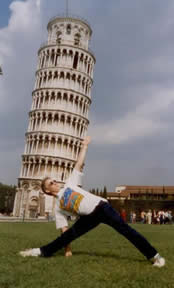 10. Use the inner groin highway extending to inner heel for the back leg in the fish body standing poses, trikonasana, parsvakonasana, vira II, and ardha chandrasana. Feel the extension like a skater pushing out through the inner edge of the skate blade. The dominant energy flow is from the pelvis into the back leg, creating a deeper opening to the front leg groin.
10. Use the inner groin highway extending to inner heel for the back leg in the fish body standing poses, trikonasana, parsvakonasana, vira II, and ardha chandrasana. Feel the extension like a skater pushing out through the inner edge of the skate blade. The dominant energy flow is from the pelvis into the back leg, creating a deeper opening to the front leg groin. 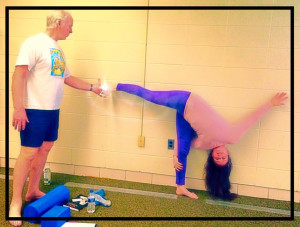 This can be further explored in this variation of half moon I call the mushroom. Here I am asking yoga teacher Amy Christine McCoy to drop her back leg slightly, without losing the inner length. this allows the whole outer leg, including ITB, glute medius, piraformis, to relax into the support of the inner line. Many students hold the back leg from the outer line, which breaks the connection to the heart/core/organ energy. Notice also the ‘stem of the mushroom’, the standing leg, how the down and up energies are in balance and the whole torso ‘floats’ above the standing leg femur head. No compression, lots of space and lightness. This is sthira sukham in action. (see below)
This can be further explored in this variation of half moon I call the mushroom. Here I am asking yoga teacher Amy Christine McCoy to drop her back leg slightly, without losing the inner length. this allows the whole outer leg, including ITB, glute medius, piraformis, to relax into the support of the inner line. Many students hold the back leg from the outer line, which breaks the connection to the heart/core/organ energy. Notice also the ‘stem of the mushroom’, the standing leg, how the down and up energies are in balance and the whole torso ‘floats’ above the standing leg femur head. No compression, lots of space and lightness. This is sthira sukham in action. (see below)
 11. Now take this action into the one legged dog pose, moving in and out of flipping the dog if your shoulder allows. Continue to elongate out through pelvis and legs, but also extend out through heart into crown chakra and arms, like plank pose. This double action centered in the heart allows you to remain balanced as you go deeper into the flip.
11. Now take this action into the one legged dog pose, moving in and out of flipping the dog if your shoulder allows. Continue to elongate out through pelvis and legs, but also extend out through heart into crown chakra and arms, like plank pose. This double action centered in the heart allows you to remain balanced as you go deeper into the flip.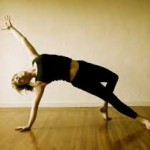 The blood vessel highway opens and becomes the perceptual source of deeper opening and movements.
The blood vessel highway opens and becomes the perceptual source of deeper opening and movements.
12. Next, use the wall to do move from one leg dog to handstand. The extended legs grounds into the wall, use the groin highway to lift the leg from the floor and extend it up to th ceiling, going into slight extension to open further. Add a bit of ‘plank heart’ and bend the back-bending leg at the knee to create a mini scorpion pose.
13. Use the same principle of groin length in coming up into head balance and elbow balance.
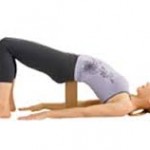 14. Supported bridge pose with a block is another wonderful way to explore the heart energy and its capacity to open the body. Gravity and leverage are used to balance energies moving to and from the heart. Use the block as a fulcrum to help lift the heart by lengthening pubic bones / tail out and down. Lengthen the inner regions without contracting the lower spinal muscles. stay grounded through the feet to help. Let the heart and then shoulders lift away from floor. Only back of skull remains grounded at that end. Then, keeping the heart reaching to the tail, let the shoulder hang/release back to the floor with out sinking. This will keep 5th chakra open and maybe even 6 and 7. All the shoulder stand variations have this opening as a foundation. ( In theory anyway!)
14. Supported bridge pose with a block is another wonderful way to explore the heart energy and its capacity to open the body. Gravity and leverage are used to balance energies moving to and from the heart. Use the block as a fulcrum to help lift the heart by lengthening pubic bones / tail out and down. Lengthen the inner regions without contracting the lower spinal muscles. stay grounded through the feet to help. Let the heart and then shoulders lift away from floor. Only back of skull remains grounded at that end. Then, keeping the heart reaching to the tail, let the shoulder hang/release back to the floor with out sinking. This will keep 5th chakra open and maybe even 6 and 7. All the shoulder stand variations have this opening as a foundation. ( In theory anyway!)
 15: Some other postures: Bakasana takes the same principles into a very compact pose. Groin length becomes groin depth as you extend out through pelvis, even as the legs are in deep flexion. The plank heart empowers the arms, and the whole core rounds and lifts simultaneously. Uncoiling the energy allows you to jump back to
15: Some other postures: Bakasana takes the same principles into a very compact pose. Groin length becomes groin depth as you extend out through pelvis, even as the legs are in deep flexion. The plank heart empowers the arms, and the whole core rounds and lifts simultaneously. Uncoiling the energy allows you to jump back to 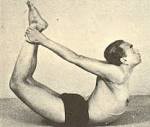 chaturanga or plank pose. Dhanurasana is the inverse: the back body coils to elongate the deep front line of the body, including heart, diaphragm, mediastinum and mesentery, as well as groins and armpits.
chaturanga or plank pose. Dhanurasana is the inverse: the back body coils to elongate the deep front line of the body, including heart, diaphragm, mediastinum and mesentery, as well as groins and armpits.
16. Spiralic action: twisting poses require a double action , like the coiled serpents and wings of the caduceus, the symbol of Hermes, the messenger of the gods in Greek mythology, also known as Mercury by the Romans. In any
, like the coiled serpents and wings of the caduceus, the symbol of Hermes, the messenger of the gods in Greek mythology, also known as Mercury by the Romans. In any 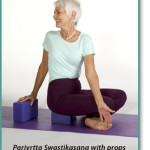 twisting pose, with the stillness of your heart at the center, feel the spinal axis or chakra line. Imagine that whatever rotation you desire will begin subtly and slowly from the deepest core of this axis. Let it radiate out slowly. Invite the opposite direction to join in the dance and allow the fluid body, open to your heart energy, respond in its own way and time. Old friend Betty Eiler shows the lightness and elegance of a heart centered twisting posture with some support from blocks.
twisting pose, with the stillness of your heart at the center, feel the spinal axis or chakra line. Imagine that whatever rotation you desire will begin subtly and slowly from the deepest core of this axis. Let it radiate out slowly. Invite the opposite direction to join in the dance and allow the fluid body, open to your heart energy, respond in its own way and time. Old friend Betty Eiler shows the lightness and elegance of a heart centered twisting posture with some support from blocks.
15. Sutras Lesson: Key sutras to ’embody’ the practice:
Chapter II, sutras 46, 47, 48; Chapter I, sutras 2, 3, 4
Patanjali has only three sutras on asana. Yoga students, and especially teachers, should know these ‘by heart’, i.e., embody them continuously. Every pose is a yoga pose, 24/7/365.
II-46, sthira sukham asanam: a yoga pose is a balance of stability and adaptability. Stability is neither static nor stagnant. It is a dynamic state that sustains its core organizing intelligence from the heart, as the world, inner and outer, changes. It is flexible and adaptable, in tune with its environment. It is an expression of the fundamental principle of aliveness.
II-47 prayatna shaithilyaananta samaapattibhyaam: with the dissolving of effort and absorption into the cosmic field (posture is mastered). When the heart field is the root of the pose, no effort is required. Then the cosmic field embraces the heart field and there is integration, wholeness, oneness.
II-48 tato dvandva anabhighaatah: Then duality is seen as an expression of wholeness, not conflict. Yin and yang, when integral to each other, are not two, but One.
These next sutras need to be experienced together to fully realize their meaning. Mind activity (citta vrttis) is normal and an inherently healthy aspect of being human. However, as we are also emotional beings in continuous relationship with others, we have an aspect of mind, known as the ahamkara in Sanskrit, that organizes our self sense, so we can, in a healthy way, differentiate self from other. The immune system is the physiological component to this process. Parenting and the attachment process plays a major role in determining whether we mature with a healthy sense of self. When love and compassion, expressions of the heart, are the center of our self sense, the mind can function in a healthy way.
The question, ‘who, or perhaps what, am I?, is a crucial seed for contemplation. From the yoga point of view, the self, the I am, is non-dual ‘Wholeness” or Purusha in the sutras, which we all ‘know’ when we are heart-centered. But it may take a while to ‘recognize’ this. We may have multiple selves, multiple identites in our mind field, not all heart based, often in conflict. We play roles in society: father/mother, daughter/son, friend, neighbor, boss, employee, etc. When mind over-rules the heart, conflicts in these various roles lead to stress, feelings of inadequacy, the need to defend ‘ourselves/beliefs/ideas against ‘others’. The transformation of these stress inducing ideas/beliefs/patterns of mind activity into an innate sense of fullness, wholeness, inner peace and equanimity, also known as spiritual maturing and the awakening of the heart, is described in the next three sutras.
I-2 Yogash citta vrtti nirodha: yoga is the dissolving of the dysfunctional mind states. The energies tied up in mental patterns based on separation, alienation and feeling inadequate are transformed into the healing energies of the heart.
I-3 tada drashtuh svarupe avasthaanam : then, wholeness, resting in its own inherent “Stillness” centered in the heart, recognizes itself and becomes stable.
I-4 vrtti sarupyam itaratra: (at other times) our beliefs about our self come from a sense of separation, are confused and inherently dysfunctional.
As these clues from Patanjali begin to resonate more and more, you will find they all lead back the the heart, that amazingly mysterious, wonderful, intense expression of being alive, of Spirit coming into matter to celebrate Itself! Rest there. Be consumed there by the fire of aliveness. Celebrate!

